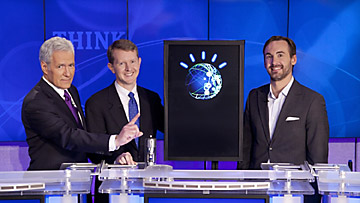QUESTION: "Not the chocolate coated candy in a wrapper,
but a rapper from Detroit."
ANSWER: Who is Eminem?
This type of pop-culture infused wordplay has made the
long-running game show "Jeopardy" popular.
 |
ELEMENTARY, MY DEAR WATSON: (from left)
"Jeopardy" host Alex Trebek and Ken Jennings and
Brad Ruttler, former winners on the game show,
pose
with WATSON, an IBM-built "super computer."
Jennings
and Ruttler are competing against the
artificial
intelligence on the show this week. Bill
Sverdlik,
an EMU professor of computer science
whose expertise
is artificial intelligence, said
WATSON represents
a true advance in the area of
natural language
processing (NLP). Photo
credit
Associated Press
|
It is the same language ambiguity that has long challenged
the development of artificial intelligence — until now.
Jeopardy will air three episodes (Feb. 14-16) that pits
an IBM built "super computer" named Watson against two
former Jeopardy champions.
"Correctly formulating questions to given answers
(the Jeopardy game) involves many linguistic gymnastics
for a computer," said Bill Sverdlik, professor of computer
science at Eastern Michigan University. "Jeopardy answer/questions
are subject to ambiguities, multiple meanings and even
cross-language problems."
Sverdlik, whose area of expertise is artificial intelligence,
will be watching the event.
The IBM Challenge is much more than a computer playing
a game, Sverdlik said.
"Many of the previous computer/human challenges involved
complete knowledge games," Sverdlik said. "Chess and checkers
are two examples of such games. Complete knowledge means
that both adversaries have total knowledge of the current
state of the game, unlike the card game bridge or poker,
where cards are hidden from players. "Winning a complete
knowledge game involves many strategies, but perhaps the
most important one is the ability to generate positions
several moves into the future. This is easy for a computer
to do."
"WATSON represents a true advance in the area of natural
language processing (NLP), the ability of a machine to
interact with humans in a natural language like English
or Spanish," said Sverdlik. "We've all had the experience
of talking to computers on an automated phone line
and some automobiles now have systems that accept voice
commands. But these systems have very limited vocabulary
and only can process a very small set of commands. WATSON
brings us one step closer to a natural language interface
with a machine."
And that knowledge can lead to a better understanding
of how humans process information.
"WATSON is attempting to automate a cognitive process.
Doing so hopefully helps us better understand our own cognitive
processes," said Sverdlik. "This is the Holy Grail of Artificial
Intelligence (AI) research: developing computer algorithms
that help us understand what it is that we humans do. Some
previous success stories in the AI community include computer
vision, object manipulation and path planning. These
areas, while well developed already, are still experiencing
wonderful new results. WATSON represents a major leap in
yet another cognitive process."
Even if you don't know anything about AI, this experiment,
aside from its entertainment value, does provide a peek
into the future.
"Any machine/human competition grabs at the imagination.
Robbie the Robot, HAL, 'I Robot' — they raise the
possibilities of machines endowed with human qualities
and human frailties, and challenge us to question
what exactly separates us from a machine. It's fun to think
about," said Sverdlik.
"This is a coming technology," he said, "Someday soon,
we all will be conversing with a computer on matters more
significant than dialing a phone number or changing the
radio station."